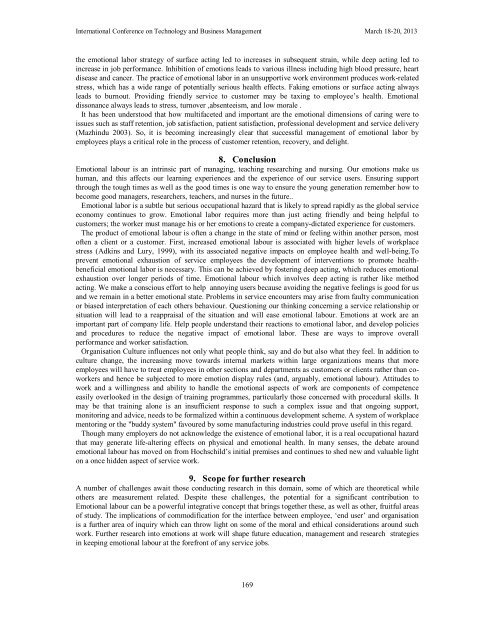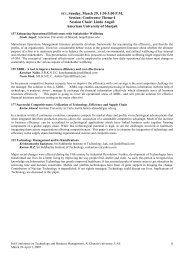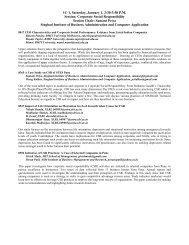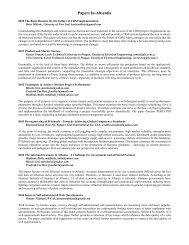Enormity of Emotional Labour and its Significance in the ... - Icmis.net
Enormity of Emotional Labour and its Significance in the ... - Icmis.net
Enormity of Emotional Labour and its Significance in the ... - Icmis.net
Create successful ePaper yourself
Turn your PDF publications into a flip-book with our unique Google optimized e-Paper software.
International Conference on Technology <strong>and</strong> Bus<strong>in</strong>ess Management March 18-20, 2013<br />
<strong>the</strong> emotional labor strategy <strong>of</strong> surface act<strong>in</strong>g led to <strong>in</strong>creases <strong>in</strong> subsequent stra<strong>in</strong>, while deep act<strong>in</strong>g led to<br />
<strong>in</strong>crease <strong>in</strong> job performance. Inhibition <strong>of</strong> emotions leads to various illness <strong>in</strong>clud<strong>in</strong>g high blood pressure, heart<br />
disease <strong>and</strong> cancer. The practice <strong>of</strong> emotional labor <strong>in</strong> an unsupportive work environment produces work-related<br />
stress, which has a wide range <strong>of</strong> potentially serious health effects. Fak<strong>in</strong>g emotions or surface act<strong>in</strong>g always<br />
leads to burnout. Provid<strong>in</strong>g friendly service to customer may be tax<strong>in</strong>g to employee’s health. <strong>Emotional</strong><br />
dissonance always leads to stress, turnover ,absenteeism, <strong>and</strong> low morale .<br />
It has been understood that how multifaceted <strong>and</strong> important are <strong>the</strong> emotional dimensions <strong>of</strong> car<strong>in</strong>g were to<br />
issues such as staff retention, job satisfaction, patient satisfaction, pr<strong>of</strong>essional development <strong>and</strong> service delivery<br />
(Mazh<strong>in</strong>du 2003). So, it is becom<strong>in</strong>g <strong>in</strong>creas<strong>in</strong>gly clear that successful management <strong>of</strong> emotional labor by<br />
employees plays a critical role <strong>in</strong> <strong>the</strong> process <strong>of</strong> customer retention, recovery, <strong>and</strong> delight.<br />
8. Conclusion<br />
<strong>Emotional</strong> labour is an <strong>in</strong>tr<strong>in</strong>sic part <strong>of</strong> manag<strong>in</strong>g, teach<strong>in</strong>g research<strong>in</strong>g <strong>and</strong> nurs<strong>in</strong>g. Our emotions make us<br />
human, <strong>and</strong> this affects our learn<strong>in</strong>g experiences <strong>and</strong> <strong>the</strong> experience <strong>of</strong> our service users. Ensur<strong>in</strong>g support<br />
through <strong>the</strong> tough times as well as <strong>the</strong> good times is one way to ensure <strong>the</strong> young generation remember how to<br />
become good managers, researchers, teachers, <strong>and</strong> nurses <strong>in</strong> <strong>the</strong> future..<br />
<strong>Emotional</strong> labor is a subtle but serious occupational hazard that is likely to spread rapidly as <strong>the</strong> global service<br />
economy cont<strong>in</strong>ues to grow. <strong>Emotional</strong> labor requires more than just act<strong>in</strong>g friendly <strong>and</strong> be<strong>in</strong>g helpful to<br />
customers; <strong>the</strong> worker must manage his or her emotions to create a company-dictated experience for customers.<br />
The product <strong>of</strong> emotional labour is <strong>of</strong>ten a change <strong>in</strong> <strong>the</strong> state <strong>of</strong> m<strong>in</strong>d or feel<strong>in</strong>g with<strong>in</strong> ano<strong>the</strong>r person, most<br />
<strong>of</strong>ten a client or a customer. First, <strong>in</strong>creased emotional labour is associated with higher levels <strong>of</strong> workplace<br />
stress (Adk<strong>in</strong>s <strong>and</strong> Lury, 1999), with <strong>its</strong> associated negative impacts on employee health <strong>and</strong> well-be<strong>in</strong>g.To<br />
prevent emotional exhaustion <strong>of</strong> service employees <strong>the</strong> development <strong>of</strong> <strong>in</strong>terventions to promote healthbeneficial<br />
emotional labor is necessary. This can be achieved by foster<strong>in</strong>g deep act<strong>in</strong>g, which reduces emotional<br />
exhaustion over longer periods <strong>of</strong> time. <strong>Emotional</strong> labour which <strong>in</strong>volves deep act<strong>in</strong>g is ra<strong>the</strong>r like method<br />
act<strong>in</strong>g. We make a conscious effort to help annoy<strong>in</strong>g users because avoid<strong>in</strong>g <strong>the</strong> negative feel<strong>in</strong>gs is good for us<br />
<strong>and</strong> we rema<strong>in</strong> <strong>in</strong> a better emotional state. Problems <strong>in</strong> service encounters may arise from faulty communication<br />
or biased <strong>in</strong>terpretation <strong>of</strong> each o<strong>the</strong>rs behaviour. Question<strong>in</strong>g our th<strong>in</strong>k<strong>in</strong>g concern<strong>in</strong>g a service relationship or<br />
situation will lead to a reappraisal <strong>of</strong> <strong>the</strong> situation <strong>and</strong> will ease emotional labour. Emotions at work are an<br />
important part <strong>of</strong> company life. Help people underst<strong>and</strong> <strong>the</strong>ir reactions to emotional labor, <strong>and</strong> develop policies<br />
<strong>and</strong> procedures to reduce <strong>the</strong> negative impact <strong>of</strong> emotional labor. These are ways to improve overall<br />
performance <strong>and</strong> worker satisfaction.<br />
Organisation Culture <strong>in</strong>fluences not only what people th<strong>in</strong>k, say <strong>and</strong> do but also what <strong>the</strong>y feel. In addition to<br />
culture change, <strong>the</strong> <strong>in</strong>creas<strong>in</strong>g move towards <strong>in</strong>ternal markets with<strong>in</strong> large organizations means that more<br />
employees will have to treat employees <strong>in</strong> o<strong>the</strong>r sections <strong>and</strong> departments as customers or clients ra<strong>the</strong>r than coworkers<br />
<strong>and</strong> hence be subjected to more emotion display rules (<strong>and</strong>, arguably, emotional labour). Attitudes to<br />
work <strong>and</strong> a will<strong>in</strong>gness <strong>and</strong> ability to h<strong>and</strong>le <strong>the</strong> emotional aspects <strong>of</strong> work are components <strong>of</strong> competence<br />
easily overlooked <strong>in</strong> <strong>the</strong> design <strong>of</strong> tra<strong>in</strong><strong>in</strong>g programmes, particularly those concerned with procedural skills. It<br />
may be that tra<strong>in</strong><strong>in</strong>g alone is an <strong>in</strong>sufficient response to such a complex issue <strong>and</strong> that ongo<strong>in</strong>g support,<br />
monitor<strong>in</strong>g <strong>and</strong> advice, needs to be formalized with<strong>in</strong> a cont<strong>in</strong>uous development scheme. A system <strong>of</strong> workplace<br />
mentor<strong>in</strong>g or <strong>the</strong> "buddy system" favoured by some manufactur<strong>in</strong>g <strong>in</strong>dustries could prove useful <strong>in</strong> this regard.<br />
Though many employers do not acknowledge <strong>the</strong> existence <strong>of</strong> emotional labor, it is a real occupational hazard<br />
that may generate life-alter<strong>in</strong>g effects on physical <strong>and</strong> emotional health. In many senses, <strong>the</strong> debate around<br />
emotional labour has moved on from Hochschild’s <strong>in</strong>itial premises <strong>and</strong> cont<strong>in</strong>ues to shed new <strong>and</strong> valuable light<br />
on a once hidden aspect <strong>of</strong> service work.<br />
9. Scope for fur<strong>the</strong>r research<br />
A number <strong>of</strong> challenges await those conduct<strong>in</strong>g research <strong>in</strong> this doma<strong>in</strong>, some <strong>of</strong> which are <strong>the</strong>oretical while<br />
o<strong>the</strong>rs are measurement related. Despite <strong>the</strong>se challenges, <strong>the</strong> potential for a significant contribution to<br />
<strong>Emotional</strong> labour can be a powerful <strong>in</strong>tegrative concept that br<strong>in</strong>gs toge<strong>the</strong>r <strong>the</strong>se, as well as o<strong>the</strong>r, fruitful areas<br />
<strong>of</strong> study. The implications <strong>of</strong> commodification for <strong>the</strong> <strong>in</strong>terface between employee, ‘end user’ <strong>and</strong> organisation<br />
is a fur<strong>the</strong>r area <strong>of</strong> <strong>in</strong>quiry which can throw light on some <strong>of</strong> <strong>the</strong> moral <strong>and</strong> ethical considerations around such<br />
work. Fur<strong>the</strong>r research <strong>in</strong>to emotions at work will shape future education, management <strong>and</strong> research strategies<br />
<strong>in</strong> keep<strong>in</strong>g emotional labour at <strong>the</strong> forefront <strong>of</strong> any service jobs.<br />
169







